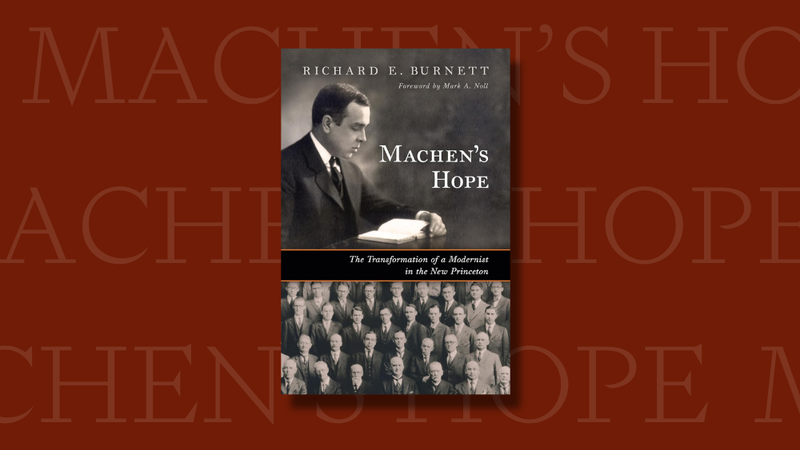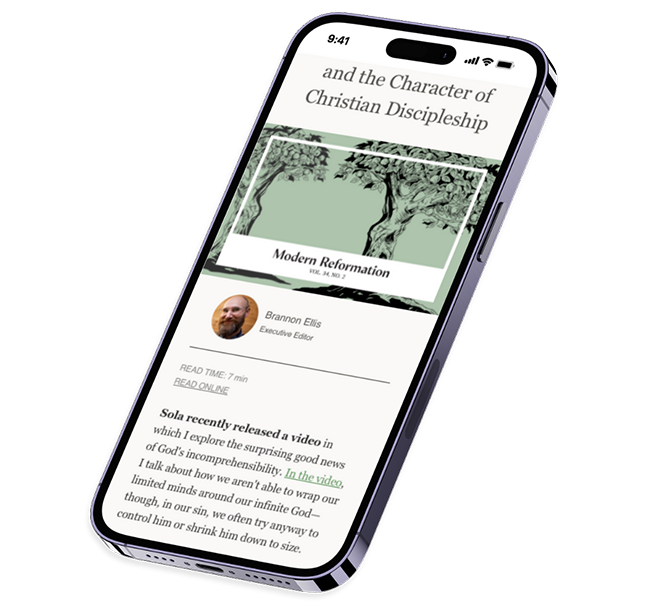Machen’s Hope: The Transformation of a Modernist in the New Princeton
by Dr. Richard E. Burnett
Eerdmans | 2024 | 638 pages (hardcover) | $45.99
Otto von Bismarck said that a wise man learns from the mistakes of others. This is a task in which books are often invaluable guides. Machen’s Hope: The Transformation of a Modernist in the New Princeton exemplifies this principle, offering readers the chance to learn, in just under 600 pages, lessons that took J. Gresham Machen a lifetime to understand. Dr. Richard E. Burnett (PhD, Princeton Theological Seminary) takes readers on a fascinating journey through Machen’s moral and intellectual development, highlighting one major theme that runs through the whole of his life. In this way, Burnett splits from both Ned Stonehouse and D. G. Hart’s previous works on Machen. That intellectual thread is what Burnett dubs “Machen’s Hope.” As the subtitle suggests, the work traces the transformation of that hope throughout Machen’s life and work. It is a hope that never dies but is transformed—baptized, one might say—by the end of his journey.
Summary
John Gresham Machen was born in 1881 to an affluent Southern Presbyterian family in Baltimore, Maryland. His upbringing was representative of the Protestant aristocracy of his day. Additionally, he grew up in a revolutionary time and a revolutionary place in the history of American education: walking distance from the newly minted Johns Hopkins University.
Johns Hopkins University pervaded every aspect of the Machens’ intellectual life. The family regularly attended lectures at the university. They even hosted the President for dinner. At an early age, Machen became very much enamored with the modern university methods being applied at Hopkins. This was the beginning of what Burnett calls “Machen’s Hope”—his deep and abiding belief in the promise of science, textual criticism, education, and the modern university system.
At age seventeen, Machen began his studies at Hopkins, pursuing a degree in the Classics. He excelled in his undergraduate studies but was unsure of his future when he graduated in 1901. He soon yielded to the counsel of the new pastor of the Franklin Street Church who suggested that Machen try out Princeton Theological Seminary. Machen yielded to his counsel, not because he felt a call to ministry, or even to academic service to the church, but out of intellectual curiosity.
No small factor in this decision was the rise of Princeton University’s new president, Woodrow Wilson. Wilson was a Hopkins graduate and spoke of his desire to make Princeton a first-rate American university. Nevertheless, Machen was a seminary student, not a university student. Machen’s displeasure with this reality was evident during this period. He regularly complained of the academic ease and flippancy that, in his estimate, characterized seminary life.
Machen entered Princeton in 1902 and left for Germany in 1905. Here he studied higher critical methods for one year, which left an indelible mark. It was in Germany that he encountered Wilhelm Hermann, a prominent liberal scholar. Hermann rejected many tenets of Christian orthodoxy yet maintained all the appearances of a robust faith. This paradox was an unsettling anomaly to Machen. Hermann’s influence heightened what was already a deep intellectual tension in Machen’s thinking: the tension between modern criticism and the Christian faith.
Though Machen never officially adopted these liberal beliefs, he struggled with them deeply. He loved the rigor of higher criticism and believed the Bible should be able to withstand whatever criticism threw at it. At the same time, he was uncomfortable with the conclusions of this method in many whom he admired.
In 1906, Machen returned to Princeton to serve as an instructor of Greek and New Testament and continued to wrestle through what the conclusions of criticism meant for his faith. Over time he reached more orthodox conclusions. However, it would take until March 5, 1911, for Machen to realize the futility of his hope in the university system.
This “day of inspiration” as he called it, came when George Washburn, the former president of Robert College in Constantinople, delivered a series of “Mission Lectures.” Machen described these lectures as “masterly” as Washburn spoke of how “the very vitals of the faith are attacked” at theological seminaries. But the most impactful statement Washburn made was that he wished he was a young man again, to give his life in the fight for Christian orthodoxy, what he dubbed “the great struggle of the Church.”
As these words rang out, Machen realized the utter futility of much of his own work at Princeton. He records that it was at that moment that “the full seriousness of the conflict became startlingly clear.” He concluded his reflections on this address by stating: “There is only one thing to say—‘Not by might, nor by power, but by thy Spirit, O Lord God of Hosts.’”
This marks the beginning of the transformation of Machen’s hope. Before, Machen saw university methods as the hope and promise of America. However, his initial hope in the university as a positive force for progress gave way to a deeper skepticism in its very foundations.
In 1913, Machen expressed a desire to come under the care of a presbytery and was ordained in June of 1914. His promotion to assistant professor at Princeton also came in May of that same year.; Machen had decided Princeton was where he wanted to spend his life. It was here that he would fight in that great struggle of the church.
Unfortunately, in his estimation, Princeton began a downhill trajectory shortly thereafter. The same Princeton that was built upon the sturdy confession of the Westminster Standards now tolerated Christological heresy in search of the “historical Jesus.” By the end of the spring semester of 1916, Machen saw clearly that the seminary had entered a new era. He realized that the new standards of academic freedom would eventually push out any principled Conservative. Though Machen’s own career saw much fruit while at Princeton, he knew “Old Princeton” would not survive much longer.
Princeton’s crusade against supernatural Christianity eventually led to Machen’s departure from the faculty in 1929. The details of this departure and the founding of Westminster Seminary go beyond the scope of this book and, likewise, this book review. Nevertheless, Burnett’s work continues to document the transformation of Machen’s hope even following his departure from Princeton.
Perhaps the clearest indication of the transformation of Machen’s hope is shown in his later role as an advocate for the Christian education movement. Burnett states, “Now it was not scholarship but Christian scholarship that he emphasized. There was no more talk about university ideals. The hope he once had in the ideals of the New Princeton had been crucified, dead, and buried. Now he hoped for the resurrection of a new transfigured form of the Old Princeton.” Machen likewise began stressing the necessity of Christian schools for the propagation of Western Civilization. In 1934, he even delivered an address at the Educational Convention of the National Union of Christian Schools, entitled “The Christian School: The Hope of America.” Machen’s faith in the secular university as the promise of the world gave way to a deep and abiding conviction that Christ alone could fulfill such a hope.
Machen died of exhaustion with pneumonia on January 1, 1937, in Bismarck, North Dakota. He had been on a speaking tour, seeking to raise money for the cause of theological education at Westminster Seminary. Earlier in his life, one substance of his hope in the university system of America was the great deal of philanthropy that supported it. However, such philanthropy was not as readily available for his new hope of Christian education. Burnett records the following: “In a telegram to John Murray, his last recorded words were ‘I’m so thankful for the active obedience of Christ. No hope without it.’ Testifying to his eternal hope, Machen’s hope for education in America and for the church had been completely transformed.”
Critical Evaluation
The strengths and weaknesses of this book often intertwine. At nearly 600 pages, it is undeniably lengthy, particularly considering that it does not delve into the details of Machen’s departure from Princeton or his founding of Westminster Theological Seminary—arguably the most exhilarating period of his life. However, the book provides an extensive contextual backdrop, exploring the histories of Machen’s parents and siblings, as well as their Southern Presbyterian heritage. Additionally, it offers significant context concerning Johns Hopkins University, the German university most broadly, and the history of Princeton Seminary and University. Burnett considers such institutions at length, emphasizing both their broader cultural significance, as well as their formative influence on Machen.
This wealth of background information is compelling, though, at 580 pages, its sheer volume can make the book feel daunting. Despite its length, Machen’s Hope is nevertheless engaging from start to finish. The author is both an excellent researcher and a clear writer. The level of detail is not for the faint of heart, but for those who give it the attention it deserves, the book offers a depth of insight that makes the effort well worth it. For instance, Burnett relies heavily on Machen’s personal correspondence, particularly his letters to his mother. The inclusion of these extensive excerpts is a great strength of the work. Burnett effectively highlights key elements in these letters, emphasizing the recurring theme of hope throughout Machen’s life. The repetition of significant quotes serves a pedagogical purpose, reinforcing the book’s central themes.
Burnett’s engagement with existing scholarship is another commendable aspect of the book. He carefully denotes where his interpretations diverge from those of previous scholars, such as D. G. Hart and Ned Stonehouse, which provides valuable insights into the historiographical debates surrounding Machen’s life. For historical context on Princeton, Burnett draws heavily on the work of well-known scholars Mark Noll and George Marsden, whose contributions lend additional depth and credibility.
Overall, this is a remarkable work of scholarship that offers a detailed and nuanced portrait of one of the most significant figures in conservative evangelicalism. Its greatest value, however, lies in the profound lesson embedded in Machen’s life. Burnett convincingly portrays Machen’s journey as one of transformation—what he identifies as a transformation of hope.
Burnett offers valuable insights into the development of Machen’s theology, shedding light on the fundamentalist-modernist debates in a way that those familiar with the controversy will find deeply illuminating. Beyond the historical analysis, this work personalizes the conflict by exploring the intellectual tensions Machen experienced as he navigated these issues. It distills a profound lesson from his life: the futility of knowledge apart from Christ. Readers can grasp in a matter of hours the truths Machen wrestled with over decades. For these reasons, I wholeheartedly commend Machen’s Hope as an enriching read for all. Whether for the professor or the plowman, this work offers wisdom and insight that transcend time and circumstance.







